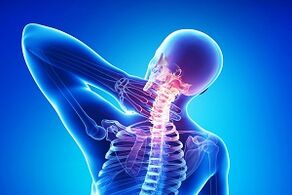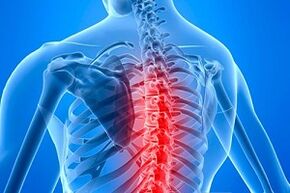Osteochondrosis is a pathology provoked by degenerative processes in cartilage tissue.In most cases, stable functioning of the intervertebral discs is noted, so it is most often referred to as spinal osteochondrosis.
Pathogenesis
First of all, osteochondrosis is associated with the fact that a person is in a standing position for a long time, which provokes an increased load on the spine and intervertebral discs.
With age, the functionality of blood vessels decreases, the diet becomes less balanced, the body ages, which only accelerates the development of pathological processes.

Osteochondrosis is a multifactorial disease;the main prerequisites for its development can be:
- work associated with vibrations or in which the position of the body often changes (flexion-extension, turns, turns, sudden movements);
- weight lifting;
- overweight;
- multiple pregnancy;
- lack of vitamins in the body;
- sedentary lifestyle;
- sleep on a soft mattress;
- bad posture (scoliosis);
- vertebral instability.
Aggravation of the dystrophic process of disc destruction can be associated with intense physical activity (especially without pre-warming), injuries or skeletal pathology that changes the distribution of the load on the spine.
Characteristic signs of pathology
Numbness and pain, as the main manifestations of osteochondrosis, can be observed in the whole body or only in the back.The pain is aggravated by sudden movement, physical activity, and in some cases by sneezing or coughing.The body's attempt to protect itself from pain leads to increased muscle tension and limited mobility.
If a person is not given help and does not start treatment, the pain intensifies even more, spreads to the limbs and limits their mobility.When the cervico-thoracic spine is affected, the hands are affected, and the lower limbs are affected in the lumbar spine.
Symptomatic manifestations differ depending on which part of the spine is affected.
Types and symptoms of osteochondrosis
Pathology can affect different parts of the spine.Considering the localization, osteochondrosis can develop in the cervical (more than 25% of diagnosed cases), lumbar (more than 50%) or thoracic (12%) regions.
Aggravation of the dystrophic process of disc destruction can be associated with intense physical activity (especially without pre-warming), injuries or skeletal pathology that changes the distribution of the load on the spine.
Osteochondrosis of the neck
Through the cervical region pass the spinal cord, arteries (supplying the brain), nerve trunks and roots (creating a nerve connection with the arms, lungs and heart).Over the years, especially in people who are not trained or work for a long time at a computer, the movements of the neck become difficult.
Symptoms characteristic of cervical osteochondrosis:
- headache and heartache;
- dizziness (short-term loss of consciousness is possible, which is associated with impaired blood supply to the brain);
- numbness and pain in the shoulder joints or arms.
Osteochondrosis of the thoracic region

Pain in the chest area is familiar to people who often and for a long time engage in physical labor, representatives of "sedentary" professions (architects, designers, drivers).
The main symptoms of osteochondrosis of the chest:
- feeling of "pile in the chest";
- painful sensations in the cervical region, between the shoulder blades;
- numbness of the hands (temporary, long-term);
- hearing and vision impairment;
- increased sweating;
- headache radiating to the back of the head (often prolonged, up to 12 hours);
- changes in blood and intracranial pressure;
- tachycardia and arrhythmia.
A good prevention of thoracic osteochondrosis is the correct posture.
Symptoms of lumbar osteochondrosis
The health problems caused by osteochondrosis in the lumbar region are as follows:
- frequent urination;
- numbness of the limbs;
- vertigo;
- muscle spasms and cramps;
- difficulty moving, bending and turning the body;
- development of scoliosis;
- pain in the lower back, especially in the morning, immediately after waking up;
- impaired muscle sensitivity and tone.
Pain and its intensity reach their peak during the acute period of the disease.Their duration can bother a person for several days, but sometimes the pain lasts for weeks and even months.As the pathological process in the intervertebral discs progresses, the severity of symptoms decreases.After 60 years, the disease becomes chronic, the pain disappears.
Stages of the disease
Osteochondrosis is a progressive pathology, the transition to each subsequent form occurs gradually.One of the stages is the formation of a hernia, which occurs when the annulus fibrosus thins.The rupture results in bulging of the nucleus, compression of the roots, resulting in increased pain and a decrease in the cushioning ability of the disc.
The main stages of development of osteochondrosis:
- A person develops characteristic complaints caused by physical exertion or prolonged stay in one position.The X-ray shows a slight narrowing of the spaces between the vertebrae.
- Loss of disc stability, cartilage tissue stretches into the annulus fibrosus, and nerve roots are compressed.X-ray shows a decrease in the intervertebral distance, displacement of the vertebrae and proliferation of bone tissue.
- Intervertebral hernias develop.The disc moves further and further into the surrounding tissue.The disorder provokes damage to nerves and blood vessels.The pain intensifies, there is numbness and limitation in the movement of the limbs.
- The disc hardens and is replaced by a scar.In fibrosis, bony protrusions grow along the edge and the distance between the vertebrae decreases significantly.The mobility of the spine decreases, it seems to ossify.
Diagnosis of osteochondrosis
The preliminary diagnosis is made by a doctor based on the patient's complaints and after a visual examination.Pain and tenderness at certain points, the state of muscle tone, range of motion, and the presence of posture disorders (for example, signs of scoliosis) are taken into account.
The presence of osteochondrosis and its stage are clarified after conducting instrumental research methods.First of all, an X-ray of the part of the spine of interest is prescribed.
After studying the images, the specialist determines:
- whether the intervertebral distance has decreased;
- whether the cartilage tissue is depleted;
- at what stage is the ongoing pathological process.
If an intervertebral hernia is detected in a patient, an MRI is prescribed.Using layer-by-layer scanning and visualization of the soft tissues, the preliminary diagnosis can be confirmed or refuted with high accuracy.
How to treat osteochondrosis
The therapy of the disease is long-term, the main goal is to relieve pain and muscle tension and, after identifying the provoking cause, to stop the development of the pathological process.
The specialist decides which method of treatment will be most effective based on the results of the examination and the severity of the ongoing pathology.process.
Drug treatment of osteochondrosis

The main goal in this type of disease is to stop the inflammatory process and pain, relieve muscle spasm.This can be done by giving the patient:
- Nonsteroidal anti-inflammatory drugs.To reduce skeletal muscle tone, muscle spasms and nerve root compression, the specialist supplements NSAIDs with muscle relaxants.
- Vitamin preparations of group B.
The optimal duration of treatment is 7-10 days.
The drug is often supplemented by local treatment.Warming ointments or gels containing NSAIDs can be applied to the affected area, which helps to improve blood supply, metabolism and stop inflammation.External drugs quickly relieve pain, because the main active substance penetrates the inflammation and immediately begins to "work".
Medication is usually supplemented with exercise, massage, physio-reflexology or manual therapy.
The main task of people suffering from osteochondrosis is to reduce the frequency and severity of pain symptoms (especially during exacerbations).Compliance with the doctor's recommendations and the use of drugs in combination with physical therapy exercises will help to restore the normal functioning of the spine and avoid surgical intervention.















































